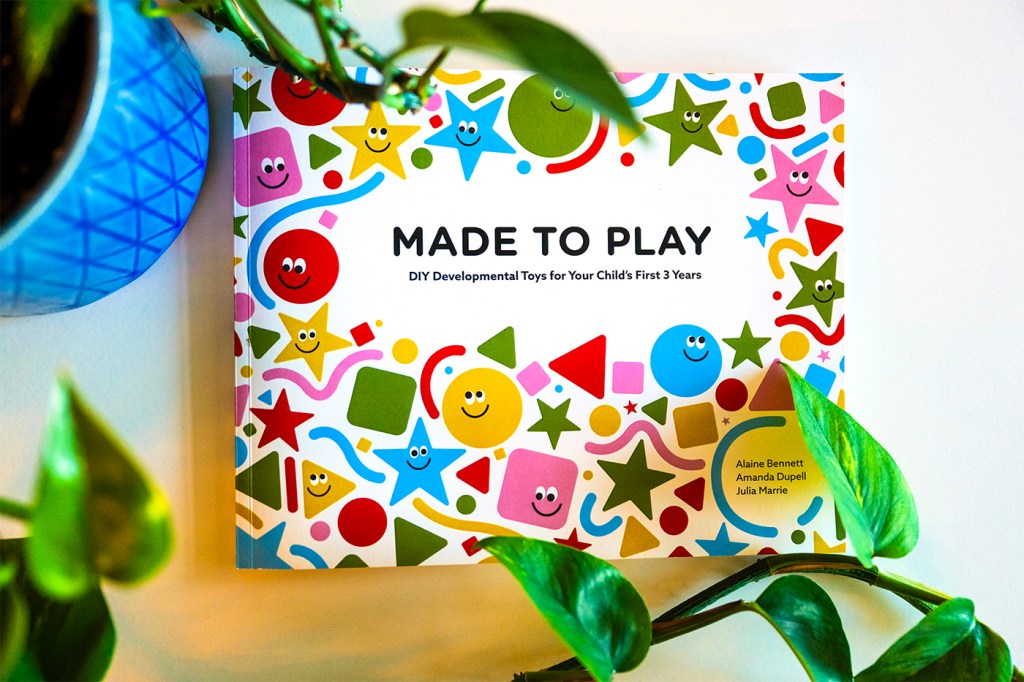Boston parents will get a
new child development book written by
Northeastern students
Now available in libraries and community centers in Boston, the book aims to help parents of children 0 to 3 with fun, easy and engaging toy ideas.

For parents in Boston looking for some help understanding a little more about how, or if, their child is developing appropriately, there’s a new book on the way.
“Made to Play,” which is printed and distributed by the city of Boston, is a handbook designed to help parents of children through 3 years old monitor their child’s development using easy-to-make toys and fun exercises. The book will soon be available citywide in nine languages through Boston Public Libraries, childcare centers and the city’s Countdown to Kindergarten playgroups for families with kids up through age 3.
With the book officially available in libraries and community centers around the city, three Northeastern University students will be among those who are most excited to see it in parents’ hands, partly because they wrote it.
Alaine Bennett, Amanda Dupell and Julia Marrie, who all graduated from Northeastern in 2022, created “Made to Play” for their senior year design program capstone project. It’s the product of countless hours of research, design, prototyping and iteration –– and a unique partnership between Northeastern and the city of Boston.
“We were so incredibly proud of what we came up with, but I don’t think we ever imagined that it would have caught the attention of the city and it would have reached this far,” Bennett says. “We’re ecstatic that our project is actually getting out there and doing some good.”
The project started as a collaboration with East Boston Social Centers, which provide free and low-cost day care to families in East Boston. Representatives from EBSC and the city gave students an overview of the early childhood education and awareness and the gaps that exist. Michael Arnold Mages, an assistant professor of art and design at Northeastern, tasked the students in his capstone class with creating design projects that could fill those gaps.
“This is the time of life where the most development, the most learning, the most brain growth goes on, and it’s also the least resourced part of life,” Mages says. “When you get into kindergarten, there’s all kinds of benefits that kick in, but [during] that early childhood 0 to 5 time period, parents aren’t necessarily left on their own but there’s a lot less support for this time period.”
Bennett says that even though EBSC and the city provide a lot of resources for parents, it can sometimes be a challenge to get parents to ask questions or actually access those resources. As a physical book, “Made to Play” was designed to get out into the community and reach parents where they are.
During the first half of the two-semester capstone, Bennett, Dupell and Marrie focused exclusively on research and deciding on the concept for their project.
As design students, they didn’t know the ins and outs of child development. They had to quickly learn a lot about how children develop motor and cognitive skills during these vital early years and, importantly, integrate those lessons into their book in an accessible way. Using resources from organizations like the Centers for Disease Control and Prevention, academic research and even the lessons Bennett was learning in her developmental psychology class, they started to select which toys would work best for what was originally just East Boston parents.
“It was less about reinventing the wheel –– it’s not like we invented any of these toys –– and more about assessing everything that’s out there and how it relates back to the research,” Marrie says.
“Made to Play” features 16 toys spread across four sections broken down by age groups: 0 to 6 months, 6 to 12 months, 12 to 24 months and 24 to 36 months. Each toy “chapter” includes instructions for how to make the toy, information on how it will help with development and a guided play activity.
Editor’s Picks
The goal of the book is to provide an accessible resource that any parent can pick up and use, so each toy can be built using common household items. For example, the rattle is built using an empty spice container and items like beads. It’s designed to test a child’s attention span, cognitive abilities like object permanence and motor skills.
“We tried to make it a little less scary,” Bennett says. “A lot of new parents are very fearful about ‘Is this happening? What should I do here?’ We really wanted to make it accessible and easy to understand.”
At the end of the book parents can find a glossary of developmental terms, and the authors also direct parents to additional resources and organizations where they can find even more information and assistance.
About halfway through the first semester of their capstone project, all students in the capstone class presented their ideas to representatives from the city of Boston, who provided feedback. The students then presented their final projects to the city in April 2022. Bennett says they received a lot of positive reactions from city officials, but they never thought the team would end up working with the city to get the book into the hands of actual parents.
With the book now available for parents, Dupell says the project is a reminder of what good design can really do.
“Actually working with people in a community is hugely impactful and something, especially as a designer, you think about because design is for everyone,” Dupell says. “This experience, for me, made that very clear. You’re designing with everyone in mind, but you also need to engage real people.”










